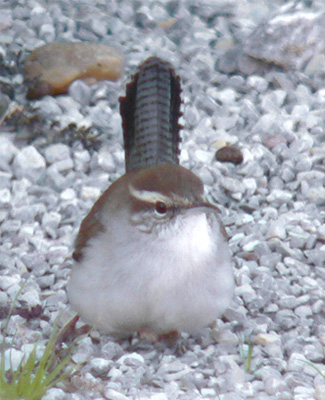
When I think of Bewick’s Wren (Thryomanes bewickii), usually about the first thing that comes to mind is pronunciation. Checking on the internet, I see that it IS pronounced “BU-ick” (as in the car), not “BEE-wick.” This brings to mind several other pronunciation challenges that have to do with bird names. For the Pileated Woodpecker pronunciation is correct as either “PIE-lee-ay-tid” or “PILL-ee-ay-tid,” which is a relief to me and likely others who fumble around with this question from time to time. Plover can be PLO-ver or (the more British-sounding) PLUHV-er. Speaking of pronunciation, the Vaux’s Swift of the far western U.S. (not an Oklahoma bird) has an interesting story related to it that indicates what a slippery slope pronunciation can be. Many years ago, at an American Ornithologists’ Union (AOU) meeting, a young man gave a presentation of his research on the Vaux’s Swift (named after William S. Vaux), which the young man pronounced as “VAUXS,” rather than VOHS (the French pronunciation of the name), Swift. After he finished his presentation at least 1 big-wig jumped on the guy for not even knowing that the name of the bird he was studying was not “VAUXS,” but “VOHS,” Swift. Then Dr. George Sutton rose to his feet and said (approximately), “Once, when I was dining at the “VAUXS” home, I asked Dr “VAUX” how he pronounced his name. He said that in France, where he had grown up, it was pronounced as “VOHS,” but now that he was an American, he felt his name should be Americanized to “VAUX”. Then Dr. Sutton sat down. Of course, not a peep was heard from anyone who had earlier criticized the young man. And I now notice on pronunciation lists the correct pronunciation of the bird’s name is given as “VAUXS” Swift, based, apparently, on how the VAUX family wanted its name pronounced in America.
Back to the Bewick’s Wren: field marks are a brown back and cap of the head, with a white strip above the eye, much stronger than the barely visible light eye stripe of the House Wren; furthermore, the Bewick’s Wren has a white or grayish-white breast, rather than the buffy brown breast that the Carolina Wren has. Bewick’s Wrens “cock their long tails up over their backs, often flicking their tails from side to side or fanning them as they skulk through tangles of branches and leaves searching for insects” (Internet, Cornell Laboratory, All About Birds).
This is a bird that both winters (in small numbers) and summers in central Oklahoma. Many years ago it was good to find even 1 on our Christmas Count, but in recent years it has been found in small, but dependable, numbers. In searching on the internet about this species, I was surprised to find its nesting distribution has shrunk westward from much of the eastern U.S. in recent decades: it has disappeared from a huge area going northeast from Oklahoma. Cornell University’s All About Birds says that “Bewick’s Wrens are still fairly common in much of western North America, but they have virtually disappeared from the East.”
Dr. G.M. Sutton (1930, The nesting wrens of Brooke County, West Virginia, Wilson Bulletin vol. 42, pp. 10-17) said that “The House Wren and the Carolina Wren may inhabit precisely the same region without friction; but the House Wren and Bewick’s Wren, or the Bewick’s Wren and Carolina Wren, or all three species, evidently do not.” Thus, Dr. Sutton, when he was state ornithologist for West Virginia, perhaps foresaw the negative competition that may now account for quite a reduction of range of the Bewick’s Wren in the eastern U.S. In Oklahoma Sutton (1967) said that the Bewick’s Wren is “less dependent than Carolina Wren on bottomland woods for nest-sites, food, and shelter, hence often found in towns, about farmhouses…” Thus, at least in Oklahoma the competition for habitat among the three wrens, Bewick’s, Carolina, and House, does not seem as fierce as it is in a huge area to the northeast and east of Oklahoma.
The Bewick’s Wren nests early in spring; Sutton (Oklahoma Birds, 1967) reported a nest in Cleveland County where “six eggs were laid before the end of February.” Sutton also reports that it “nests about sheds and deserted buildings, in natural cavities in trees, occasionally in holes in banks and in birdhouses.” According to Ridgway (1889, The ornithology of Illinois, vol. 1, pt. 1) the nest is built of “sticks, straw, coarse feathers, fine chips, etc, matted together with spiders’ webs, and lined with tow [rhymes with cow; broken fibre such as flax, hemp, or jute] and soft feathers of barnyard fowls.” It usually lays 5 to 7 eggs. On breeding territory, males have one of the more cheery bird songs we hear in spring in central Oklahoma, and it is usually sung from high perches. The Bewick’s Wren was named by Audubon after his friend, the great English wood engraver, Thomas Bewick.
